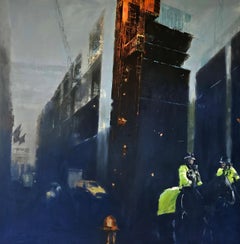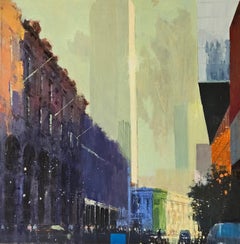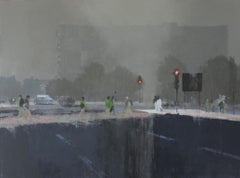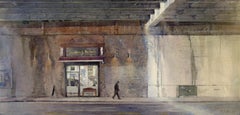David Walker Figurative Paintings
to
1
1
Overall Width
to
Overall Height
to
2
2
2
2
1
1
1
1
1
1
1
1
2
2
14
468
322
258
227
1
2
Artist: David Walker
Presence in Cannon Street
By David Walker
Located in London, GB
Award winning artist David Walker works in both oil paints and watercolours. Before concentrating on illustration and fine art painting David trained and practiced as an architect. A...
Category
2010s Modern David Walker Figurative Paintings
Materials
Oil
The View North on Bishopsgate
By David Walker
Located in London, GB
Award winning artist David Walker works in both oil paints and watercolours. Before concentrating on illustration and fine art painting David trained and practiced as an architect. A...
Category
2010s Modern David Walker Figurative Paintings
Materials
Oil
Related Items
Dump. Oil on canvas, 28. 5 x 43 cm
Located in Riga, LV
Dump. Oil on canvas, 28.5x43 cm
Category
Late 20th Century Modern David Walker Figurative Paintings
Materials
Canvas, Oil
"Shattered" WPA Mid 20th Century Modernism American Scene Surrealism Figurative
By Leon Bibel
Located in New York, NY
"Shattered" WPA Mid 20th Century Modernism American Scene Surrealism Figurative
Estate stamp on the stretcher, verso. Provenance: Estate of the artist. 20 x 24 inches.
Look at the last two photos in the listing. A new book about Leon Bibel was just published and there's a photo of the artist taken in front of the painting. Amazingness.
BIO
Leon Bibel continued painting through 1941 and resumed work in both painting and especially wood sculpture by 1960. He worked until his very last day in 1995. His last series of large wood sculptures were modeled on spice boxes, which were miniature buildings...
Category
1930s American Modern David Walker Figurative Paintings
Materials
Canvas, Oil
Vintage Modernist Abstract Figurative City Framed Oil Painting- Spanish Walks
Located in Bristol, GB
SPANISH WALKS
Size: 24 x 37 cm (including frame)
Oil on Board
An outstanding semi-abstract oil composition, painted in 1958 by the established Swedish artist Ivar Morsing (1919-2009...
Category
Mid-20th Century Modern David Walker Figurative Paintings
Materials
Oil, Board
$1,445
H 9.45 in W 14.57 in
20th C. Figurative Abstract Painting Cleveland School African American Artist
By Beni E. Kosh
Located in Beachwood, OH
Beni E. Kosh/Charles Elmer Harris (American, 1917-1993)
Untitled
Oil on canvas board
Estate stamped #611 verso
24 x 18 inches
Charles Elmer Harris was born in 1917 in Cleveland, Oh...
Category
20th Century American Modern David Walker Figurative Paintings
Materials
Oil
Figurative Cubist Surrealist Abstraction Mid 20th Century American Modern Large
By O. Louis Guglielmi
Located in New York, NY
Figurative Cubist Surrealist Abstraction Mid 20th Century American Modern Large
O. Louis Guglielmi (1906 - 1956)
OBSESSIVE THEME
44 x 33 inches
Oil on canvas
Signed and dated '48 lo...
Category
1940s American Modern David Walker Figurative Paintings
Materials
Canvas, Oil
$50,000
H 47 in W 36 in D 2 in
Mid Century Modern American Abstract Figurative Surreal Framed Oil Painting
Located in Buffalo, NY
Nicely painted mid century abstracted figurative painting. Oil on canvas. Framed. No signature found. Great color and composition. Nicely framed in a period modernist molding.
Category
1960s Modern David Walker Figurative Paintings
Materials
Canvas, Oil
$1,020 Sale Price
20% Off
H 37 in W 22 in D 2 in
Mid Century Modern Mini Abstract Figurative Oil Painting - Woman in Repose
Located in Bristol, GB
WOMAN IN REPOSE
Size: 36 x 32.5 cm (including frame)
Oil on board
A small yet very impactful mid century abstract figurative oil composition, by the established Swedish artist Ivar ...
Category
Mid-20th Century Modern David Walker Figurative Paintings
Materials
Oil, Board
$1,037
H 14.18 in W 12.8 in
"Untitled" Albert Heckman, 1950s Modernist Abstracted Still Life Painting
By Albert Heckman
Located in New York, NY
Albert Heckman
Untitled, circa 1950
Signed lower right
Oil on canvas
21 1/4 x 29 inches
Albert Heckman was born in Meadville, Western Pennsylvania, 1893. He went to New York City to try his hand at the art world in 1915 after graduating from high school and landing a job at the Meadville Post Office. In 1917, at the age of 24, Heckman enrolled part-time in Teachers' College, Columbia University's Fine Arts Department to begin his formal art education. He worked as a freelance ceramic and textile designer and occasionally as a lecturer at the Metropolitan Museum of Art. In the early 1920s, at the age of almost 30, he graduated with a Bachelor of Arts degree from Columbia Teachers College. He was especially impacted by his instructor at Columbia, Arthur Wesley Dow.
After graduating, he was hired by the Teachers' College as a Fine Arts instructor. He stayed with Columbia Teachers' College until 1929, when he left to attend the Leipzig Institute of Graphic Arts in Leipzig, Germany. Isami Doi (1903-1965), who was born in Hawaii, was arguably his most impressive student at Columbia. Doi is now regarded as one of the most prominent artists hailing from Hawaii. Heckman became an active member and officer of the Keramic Society and Design Guild of New York in the 1920s as part of his early commercial art career. The Society's mission was to share knowledge and showcase textile and ceramic design exhibits.
In 1922, Heckman married Florence Hardman, a concert violinist. Mrs. Heckman's concert schedule during the 1920s kept Albert and Florence Heckman apart for a significant portion of the time, but they spent what little time they had together designing and building their Woodstock, New York, summer house and grounds. A small house and an acre of surrounding land on Overlook Mountain, just behind the village of Woodstock, were purchased by Albert and Florence Heckman at the time of their marriage. Their Woodstock home, with its connections, friendships, and memories, became a central part of their lives over the years, even though they had an apartment in New York City.
Heckman's main artistic focus shifted to the house on Overlook Mountain and the nearby towns and villages, Kingston, Eddyville, and Glasco. After returning from the Leipzig Institute of Graphic Arts in 1930, Mr. Heckman joined Hunter College as an assistant professor of art. He worked there for almost thirty years, retiring in 1956. Throughout his tenure at Hunter, Mr. Heckman and his spouse spent the summers at their Woodstock residence and the winters in New York City. They were regular and well-known guests at the opera and art galleries in New York. Following his retirement in 1956, the Heckmans settled in Woodstock permanently, with occasional trips to Florida or Europe during the fall and winter. Mr. Heckman's close friends and artistic career were always connected to Woodstock or New York City. He joined the Woodstock art group early on and was greatly influenced by artists like Paul and Caroline Rohland, Emil Ganso, Yasuo Kuniyoshi, Andre Ruellan, and her husband, Jack Taylor.
Heckman operated a summer art school in Woodstock for several years in the 1930s with support from Columbia University, where these and other Woodstock artists gave guest lectures. The Potter's Shop in New York City hosted Mr. Heckman's first art show in December 1928. The exhibit received some positive reviews from critics. The American Institute of Graphic Arts chose the plate of "Wehlen, Saxony" as one of the "Fifty Prints of the Year in 1929." There were sixteen etchings displayed. The remaining plates depicted scenes in Saxony, Germany, while five of the plates were based on scenes in Rondout, New York.
Heckman started switching from etching to black and white lithography by the early 1930s. A lifelong admirer of Heckman's artwork, Mr. Gustave von Groschwitz organized a significant exhibition of Heckman etchings and lithographs at the Ferargil Gallery in New York City in 1933. The exhibition traveled to the Stendahl Galleries in Los Angeles (May 1933), the Charles Lessler Gallery in Philadelphia (May 1933), J.L. Hudson in Detroit (June 1933), and Gumps in San Francisco (July 1933). Together with his early etchings, the exhibition featured brand-new black and white lithographs depicting scenes in and around Woodstock as well as "A View from Tudor City...
Category
1950s American Modern David Walker Figurative Paintings
Materials
Canvas, Oil
$6,400 Sale Price
20% Off
H 30.5 in W 38.5 in
Dichotomy, mid-century figural abstract green oil painting
By Clarence Holbrook Carter
Located in Beachwood, OH
Clarence Holbrook Carter (American, 1904-2000)
Dichotomy, 1962
Oil on paper
Signed and dated upper left
20 x 25 inches
Mid-century figural abstract green painting of woman swimming ...
Category
1960s American Modern David Walker Figurative Paintings
Materials
Oil
$11,500
H 20 in W 25 in
1957 Vintage Modernist Abstract Figurative Framed Oil Painting- Senoritas
Located in Bristol, GB
SENORITAS
Size: 48 x 62 cm (including frame)
Oil on Board
An outstanding semi-abstract figurative oil composition, painted in 1957 by the established Swedish artist Ivar Morsing (1919-2009), whose works have been exhibited in public collections including the National Museum in Stockholm, Moderna Museet in Stockholm, Kalmar Museum, and Jönköping Museum.
The artwork captures the poised and elegant presence of five Spanish ladies...
Category
Mid-20th Century Modern David Walker Figurative Paintings
Materials
Oil, Board
$2,054
H 18.9 in W 24.41 in
Inevitable Day – Birth of the Atom oil and tempera painting by Julio De Diego
By Julio de Diego
Located in Hudson, NY
Julio De Diego’s Atomic Series paintings made an extraordinary statement regarding the shock and fear that accompanied the dawn of the nuclear age. In the artist’s own words, “Scientists were working secretly to develop formidable powers taken from the mysterious depths of the earth - with the power to make the earth useless! Then, the EXPLOSION! . . . we entered the Atomic Age, and from there the neo-Atomic war begins. Explosions fell everywhere and man kept on fighting, discovering he could fight without flesh.”
To execute these works, De Diego developed a technique of using tempera underpainting before applying layer upon layer of pigmented oil glazes. The result is paintings with surfaces which were described as “bonelike” in quality. The forms seem to float freely, creating a three-dimensional visual effect. In the 1954 book The Modern Renaissance in American Art, author Ralph Pearson summarizes the series as “a fantastic interpretation of a weighty theme. Perhaps it is well to let fantasy and irony appear to lighten the devastating impact. By inverse action, they may in fact increase its weight.”
Bibliography
Art in America, April 1951, p.78
About this artists: Julio De Diego crafted a formidable persona within the artistic developments and political struggles of his time. The artist characterized his own work as “lyrical,” explaining, “through the years, the surrealists, the social-conscious painters and the others tried to adopt me, but I went my own way, good, bad or indifferent.” [1] His independence manifested early in life when de Diego left his parent’s home in Madrid, Spain, in adolescence following his father’s attempts to curtail his artistic aspirations. At the age of fifteen he held his first exhibition, set up within a gambling casino. He managed to acquire an apprenticeship in a studio producing scenery for Madrid’s operas, but moved from behind the curtains to the stage, trying his hand at acting and performing as an extra in the Ballet Russes’ Petrouchka with Nijinsky. He spent several years in the Spanish army, including a six-month stretch in the Rif War of 1920 in Northern Africa. His artistic career pushed ahead as he set off for Paris and became familiar with modernism’s forays into abstraction, surrealism, and cubism.
The artist arrived in the U.S. in 1924 and settled in Chicago two years later. He established himself with a commission for the decoration of two chapels in St. Gregory’s Church. He also worked in fashion illustration, designed magazine covers and developed a popular laundry bag for the Hotel Sherman. De Diego began exhibiting through the Art Institute of Chicago in 1929, and participated in the annual Chicago Artists Exhibitions, Annual American Exhibitions, and International Water Color Exhibitions. He held a solo exhibition at the Art Institute of Chicago in the summer of 1935. Though the artist’s career was advancing, his family life had deteriorated. In 1932 his first marriage dissolved, and the couple’s young daughter Kiriki was sent to live with friend Paul Hoffman.
De Diego continued to develop his artistic vocabulary with a growing interest in Mexican art. He traveled throughout the country acquainting himself with the works of muralists such as Carlos Merida, and also began a collection of small native artifacts...
Category
1940s American Modern David Walker Figurative Paintings
Materials
Masonite, Oil, Tempera
The Magician oil and tempera painting by Julio de Diego
By Julio de Diego
Located in Hudson, NY
Julio De Diego’s Atomic Series paintings made an extraordinary statement regarding the shock and fear that accompanied the dawn of the nuclear age. In the artist’s own words, “Scientists were working secretly to develop formidable powers taken from the mysterious depths of the earth - with the power to make the earth useless! Then, the EXPLOSION! . . . we entered the Atomic Age, and from there the neo-Atomic war begins. Explosions fell everywhere and man kept on fighting, discovering he could fight without flesh.”
To execute these works, De Diego developed a technique of using tempera underpainting before applying layer upon layer of pigmented oil glazes. The result is paintings with surfaces which were described as “bonelike” in quality. The forms seem to float freely, creating a three-dimensional visual effect. In the 1954 book The Modern Renaissance in American Art, author Ralph Pearson summarizes the series as “a fantastic interpretation of a weighty theme. Perhaps it is well to let fantasy and irony appear to lighten the devastating impact. By inverse action, they may in fact increase its weight.”
Exhibited
1964 Marion Koogler McNay Art Institute, San Antonio, Texas
This work retains its original frame which measures 54" x 42" x 2"
About this artist: Julio De Diego crafted a formidable persona within the artistic developments and political struggles of his time. The artist characterized his own work as “lyrical,” explaining, “through the years, the surrealists, the social-conscious painters and the others tried to adopt me, but I went my own way, good, bad or indifferent.” [1] His independence manifested early in life when de Diego left his parent’s home in Madrid, Spain, in adolescence following his father’s attempts to curtail his artistic aspirations. At the age of fifteen he held his first exhibition, set up within a gambling casino. He managed to acquire an apprenticeship in a studio producing scenery for Madrid’s operas, but moved from behind the curtains to the stage, trying his hand at acting and performing as an extra in the Ballet Russes’ Petrouchka with Nijinsky. He spent several years in the Spanish army, including a six-month stretch in the Rif War of 1920 in Northern Africa. His artistic career pushed ahead as he set off for Paris and became familiar with modernism’s forays into abstraction, surrealism, and cubism.
The artist arrived in the U.S. in 1924 and settled in Chicago two years later. He established himself with a commission for the decoration of two chapels in St. Gregory’s Church. He also worked in fashion illustration, designed magazine covers and developed a popular laundry bag for the Hotel Sherman. De Diego began exhibiting through the Art Institute of Chicago in 1929, and participated in the annual Chicago Artists Exhibitions, Annual American Exhibitions, and International Water Color Exhibitions. He held a solo exhibition at the Art Institute of Chicago in the summer of 1935. Though the artist’s career was advancing, his family life had deteriorated. In 1932 his first marriage dissolved, and the couple’s young daughter Kiriki was sent to live with friend Paul Hoffman.
De Diego continued to develop his artistic vocabulary with a growing interest in Mexican art. He traveled throughout the country acquainting himself with the works of muralists such as Carlos Merida, and also began a collection of small native artifacts...
Category
1940s American Modern David Walker Figurative Paintings
Materials
Masonite, Oil, Tempera
Previously Available Items
Across the Divide - London cityscape crossing traffic light oil painting
By David Walker
Located in London, GB
David Walker's paintings are concerned with his ongoing fascination with the built environment and in particular, London; it’s atmospheres, moods and forms. The paintings aim to expr...
Category
2010s Abstract Expressionist David Walker Figurative Paintings
Materials
Oil, Board
Cutting Through - illustrative London cityscape architecture watercolor on paper
By David Walker
Located in London, GB
Award winning artist David Walker works in both oil paints and watercolours. Before concentrating on illustration and fine art painting David trained and practiced as an architect. A...
Category
2010s Contemporary David Walker Figurative Paintings
Materials
Paper, Watercolor
H 10.24 in W 20.87 in D 0.99 in
The Power Station-contemporary cityscape architecture London Battersea painting
By David Walker
Located in London, GB
Award winning artist David Walker works in both oil paints and watercolours. Before concentrating on illustration and fine art painting David trained and practiced as an architect. A...
Category
2010s Contemporary David Walker Figurative Paintings
Materials
Canvas, Oil
H 37.41 in W 37.41 in D 1.58 in
Brompton - contemporary London cityscape architecture oil painting
By David Walker
Located in London, GB
Award winning artist David Walker works in both oil paints and watercolours. Before concentrating on illustration and fine art painting David trained and practiced as an architect. A...
Category
2010s Contemporary David Walker Figurative Paintings
Materials
Canvas, Oil
H 29.53 in W 29.53 in D 1.58 in
Trapped Reflections -contemporary cityscape architecture painting oil on canvas
By David Walker
Located in London, GB
David’s work is primarily concerned with the built environment. The play of light and atmosphere on the manmade forms of our cities.
'The paintings aim to express a kind of curious ...
Category
2010s Contemporary David Walker Figurative Paintings
Materials
Oil, Board
David Walker figurative paintings for sale on 1stDibs.
Find a wide variety of authentic David Walker figurative paintings available for sale on 1stDibs. You can also browse by medium to find art by David Walker in oil paint, paint, board and more. Much of the original work by this artist or collective was created during the 21st century and contemporary and is mostly associated with the contemporary style. Not every interior allows for large David Walker figurative paintings, so small editions measuring 17 inches across are available. Customers who are interested in this artist might also find the work of Brian Elwell, Claire Wiltsher, and Michael Sanders. David Walker figurative paintings prices can differ depending upon medium, time period and other attributes. On 1stDibs, the price for these items starts at $1,879 and tops out at $2,631, while the average work can sell for $2,130.



